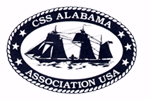
|
|
|
|
|||
|
|
|||
|
|
|||
|
|
|||
|
|
|
|
|
|
|
|
|
|
|
|
Dive Operations Useful Links Special Collections Library at the University of Alabama |
|
|
|
Article 8 Dr Gordon Watts, Principal Investigator and Archaeologist; John W. (Billy Ray) Morris, Field Supervisor and Archaeologist; Steve Brodie, Underwater Archaeologist; Mark Padover, Underwater Archaeologist; and Paul Stone, Underwater Photographer have returned from France following two months of archaeological exploration of the CSS ALABAMA. Following are excerpts from Dr. Watt's preliminary synopsis of the second phase of the year 2000 effort. The weather during the second phase was worse than during the first phase, and the team was weathered-out four of the seven days originally scheduled for diving. Two of those days were marginal and divers were only able to make short 10 minute dives decompressing without oxygen. Gordon Watts and Steve Brodie were however, able to dive on the Saturday and Sunday following the scheduled dives to make up some of the lost time. During the second period the team was able to examine the anchor exposed by the French Navy and document some of the forward sections of the wreck. The anchor appears to be underneath part of the surviving hull structure. Examination of the forward section of the wreck confirmed that a considerable portion of previously undocumented hull structure was exposed. Some additional time was spent on recording the screw lifting mechanism. Although excavation with the scooters proved to be less than highly effective, divers were able to see and video some of the propeller hub. There appears to be a possibility that the lifting frame may not be so firmly attached to the deadwood as previously thought. With the data collected it may be possible to calculate the weight of the screw and frame and determine the association between the two components. Finally, some additional material was recovered from the wreck. That included two deadlights from the bow. An additional piece of gun carriage pivot track was identified but not recovered. Amidships a single sheave block with a hook was recovered. The entire block assembly is of bronze. A small wooden box was recovered from the stern. The box measured approximately 12 inches square and appears to have something inside that was made of iron. Evidence of iron oxide was readily apparent in the water of the container in which it was transported to shore. Before leaving Gordon Watts and team worked with Dr. Ulane Bonnel, President of the French Association CSS ALABAMA and Cherbourg Maritime to make arrangements for shipping the 32-pounder cannon, artifacts and operational equipment by sea to Charleston, South Carolina. Michel Chapron, Dive Supervisor; some of the other French divers; Dr. Bonnel; and Phillipe de Vivies will work with Cherbourg Maritime in the packing and shipping of a container to Charleston. Dr. Watts will meet the container in Charleston and help get the gun and artifacts to the CSS Hunley conservation facility. |
|
|
[ home ][ css alabama ][ news ][ alabama lost ] [ artifact recovery ][ the cruise ][ the crew ][ membership ] |
|||||||